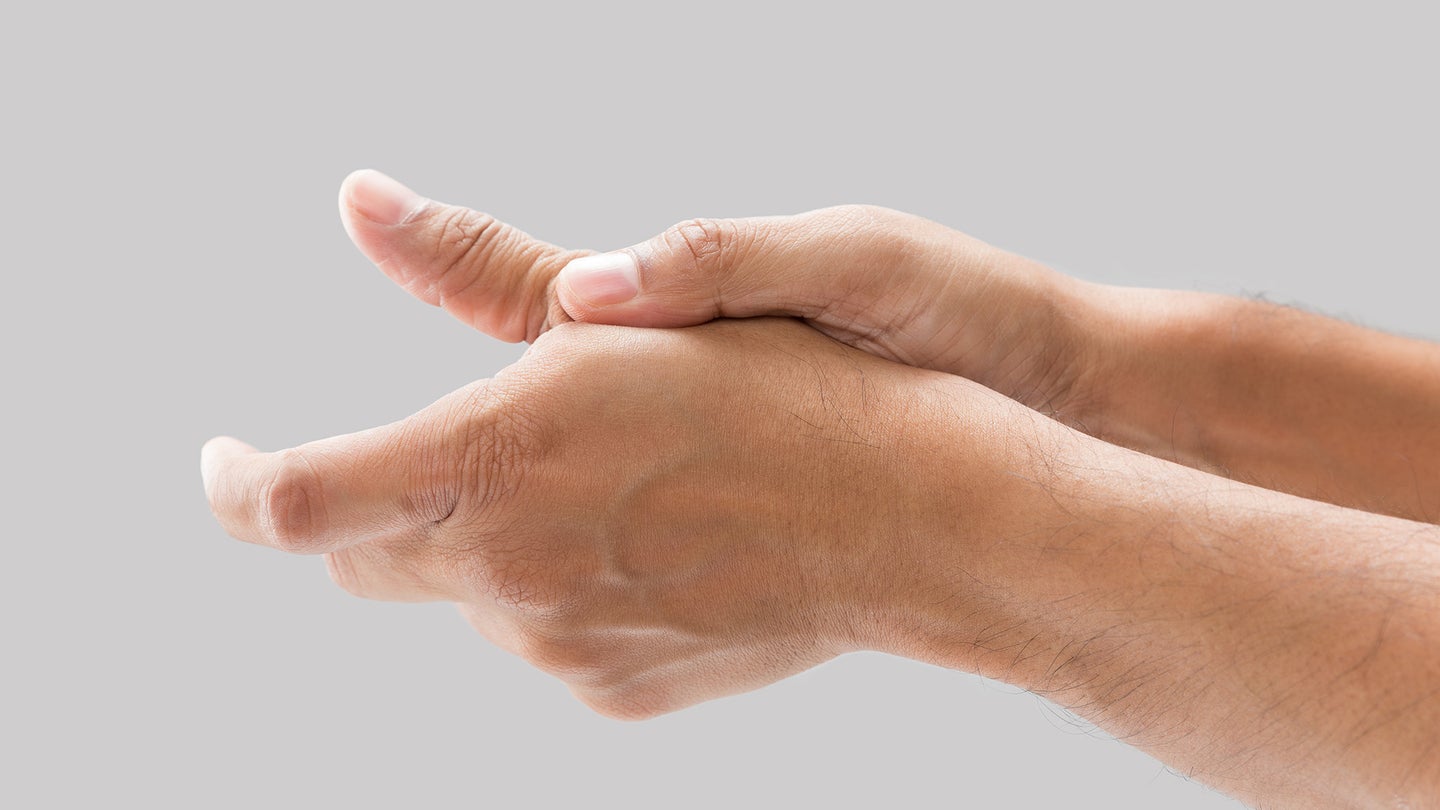How to Unjam a Finger

Adobe Stock / eddows
You’ve fallen, and thankfully, you can get up. But something is still…off. The hand you landed on is now red and tingling. Maybe you’re experiencing numbness, or can feel your heartbeat pulsing through your finger tip. You try to flatten your hand on the table, but it just kind of stays off-kilter and gnarled. Cue the Rolodex of maladies in the back of your head. It doesn’t feel like anything’s broken, but there’s definitely an ambient pain. Eventually you decide that you may have jammed your finger, though it turns out you don’t really know what that means or how to unjam a finger.
Basically, when people refer to a finger as being “jammed,” they’re using a non-technical term for a sprain to the joint or knuckle. It can happen any time the proximal inter-phalangeal (PIP) joint in the middle of your finger absorbs impact. Although it’s a common injury, it’s something you should treat right away, lest it lead to chronic problems like arthritis. So read on to find out how to determine if your finger is, in fact, jammed—and what to do about it if so.
How to Unjam a Finger: Table of contents
How do you know your finger might be jammed?
Treating a jammed finger
The healing process
A finger jam is a common sports injury that can be caused by either overextension or by hitting your finger against a blunt object, like a basketball or volleyball. Maybe you failed to catch a pass from a teammate, caught it in a door, or like this poor guy, slammed it on a wooden beam after trying to unjam a rifle in the heat of a competition.
Regardless of how a jam happens, the immediate symptoms are basically the same. The most prominent ones are swelling and discomfort. Your finger may also be numb, crooked, bent, or a different color than usual (confusingly, it may either feel hot or cold). This kind of sprain can cause a litany of problems: torn ligaments, ruptured tendons, and even fractured bones.
There are also three grades of sprain. The first indicates a small tear in the ligament, the second refers to a partial tear with bones possibly moving out of place. The third, and most severe, grade of finger jam happens when you’ve completely torn the ligament.
What’s more, if your finger is red and swollen, you might have sprained one of your collateral (or side) ligaments. If it’s tender on the bottom, you’ve likely bent the finger backward rather than properly jammed it. Lastly, if your finger can’t straighten out or is visibly bent toward your palm, you might have what’s known as “mallet finger.” An orthopedic surgeon should be able to, ahem, straighten you out.
Treating a Jammed Finger
Contrary to popular belief, you can’t just pull a jammed finger back into place. In fact, many experts recommend the opposite approach when it comes to sprains. The PRICE method stands for protect, rest, ice, compression, and elevation—and that’s exactly what you should try first upon realizing you’ve jammed your finger.
Obviously, if you are injured playing sports, you should stop immediately. Then remove all rings from the affected finger. Once you’ve done that, apply ice for 15 minutes. The goal is to reduce swelling, so raising the finger above your heart also helps. It’s also recommended to wrap the finger in an elastic bandage if one is handy. If you can move the appendage easily after this process, you’re probably in the clear.
Meanwhile, if none of this works, or if you start to develop a fever, it’s time to make a doctor’s appointment. Children with jammed fingers should also seek medical attention regardless, as damage to the growth plate of their finger bone could lead to lasting damage or impeded growth.
How to Unjam a Finger: The Healing Process
There are a couple of recommended ways to speed up the healing process after jamming your finger. Taking over-the-counter medication like ibuprofen will help keep swelling down, giving your body the opportunity to heal. You can also “buddy tape” your affected finger to the one next to it using medical cloth tape. It’s available at any drug store, waterproof, and able to be cut both horizontally and vertically. This might be enough to help you in some cases, while in others it serves as a good stopgap until you can get to the doctor for a splint. In the most severe cases, a jammed finger may require surgery.
Doctors also recommend targeted exercise as part of the post-treatment regiment. Finger presses, finger bends, and using a rubber band as a resistance tool can all help strengthen the injured appendage. Typically a jammed finger will heal in one to two weeks. But getting back to full form may take up to five months, depending on the specifics of the injury. So, as we explore how to unjam a finger, we ultimately come to a common, unsurprising answer: time.
And in order to prevent a jammed finger in the future, you should stretch before any activity that involves catching or any sort of manual dexterity. Here’s an easy exercise: Push your palms together and move your fingers back and forth in synchronicity for a few sets of 20 reps each. In just a few minutes, you’ll increase your flexibility and help you keep your palms wide open. Both are important when it comes to keeping you from getting in another jam.
The post How to Unjam a Finger appeared first on Field & Stream.
Articles may contain affiliate links which enable us to share in the revenue of any purchases made.
